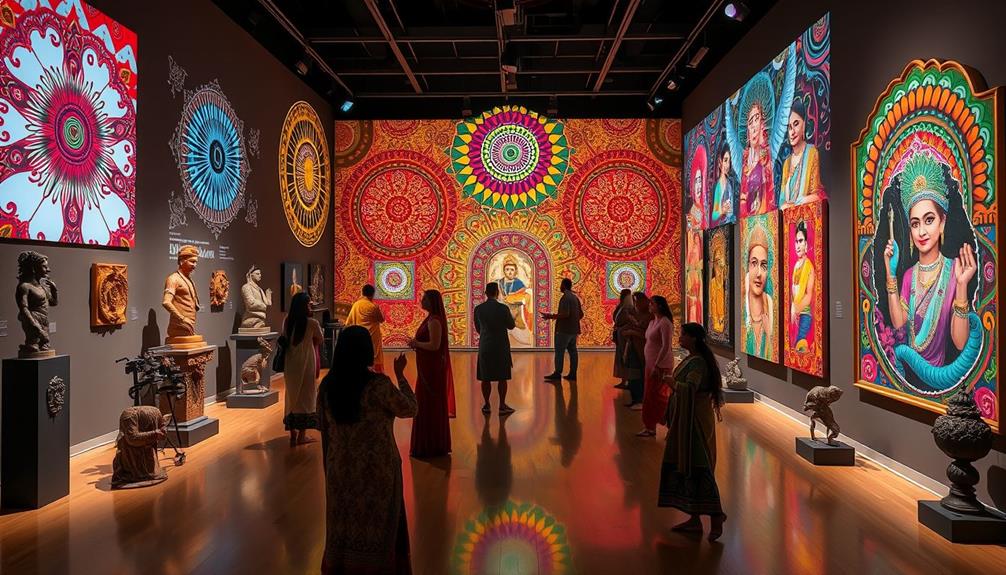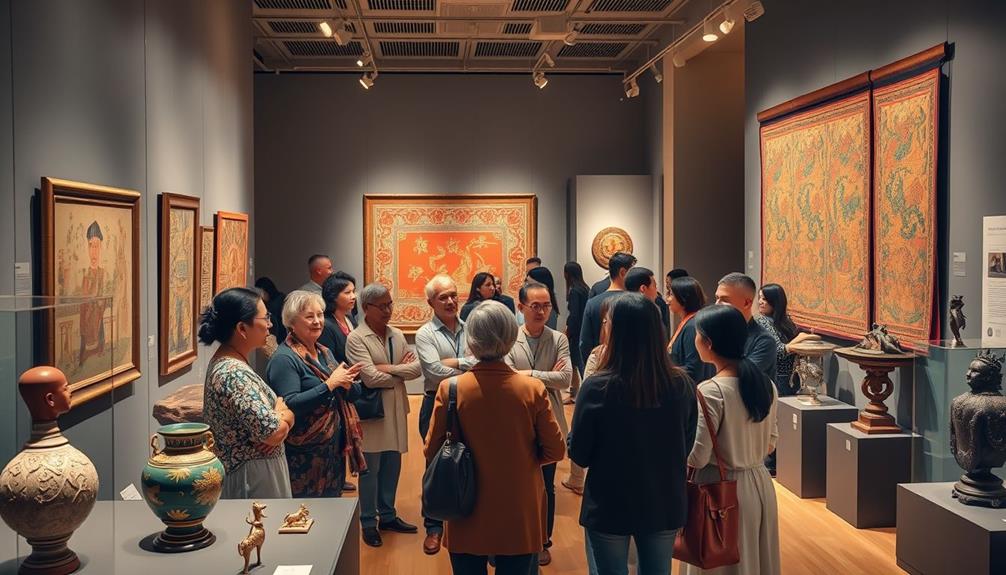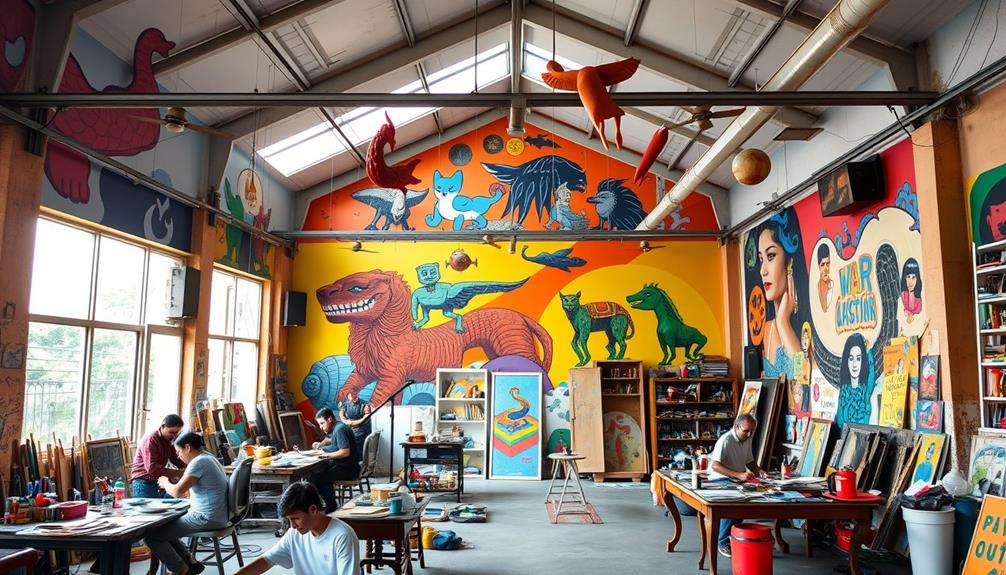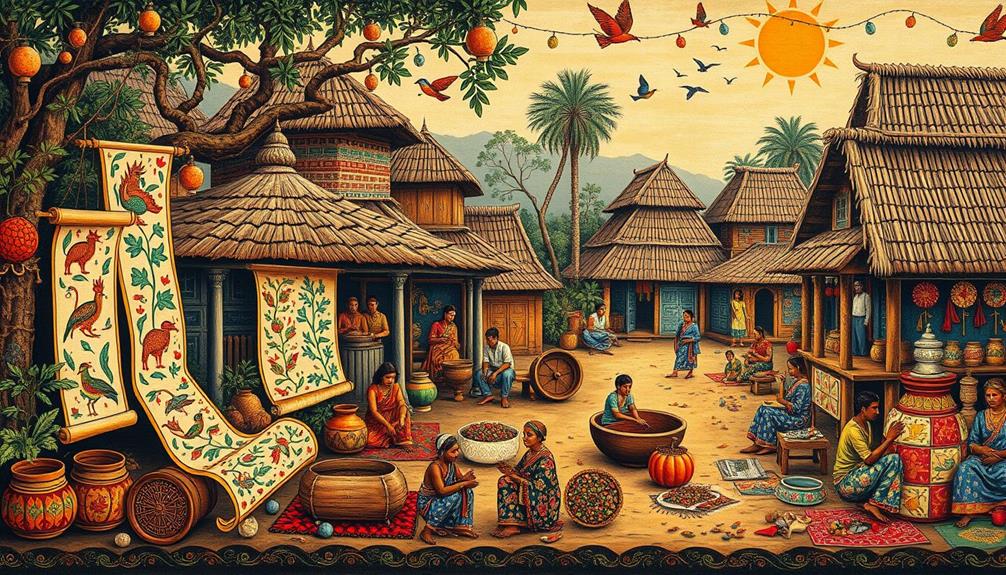You're witnessing a vibrant transformation in the Indian art scene as artists merge traditional techniques with cutting-edge innovations, redefining creative expression. Digital art, augmented reality, and interactive installations are gaining traction, allowing for immersive audience experiences. Artists like Bharti Kher and Jitish Kallat reinterpret age-old practices within contemporary contexts. Alongside this, online galleries and social media are enhancing the visibility of emerging talents. The fusion of traditional elements with modern themes is addressing important social issues too. Stick around to discover how these trends shape the future of Indian art and create new avenues for artistic exploration.
Key Takeaways
- Artists are integrating augmented reality and AI to create immersive and interactive art experiences, redefining viewer engagement.
- Digital art techniques, such as algorithmic art and digital collages, are addressing contemporary themes and expanding artistic expression.
- Collaborations between artists and international galleries foster innovative projects, blending cultural narratives and enhancing the visibility of diverse artistic practices.
- Emerging artists are utilizing street art to tackle social and political issues, merging traditional techniques with modern themes for impactful storytelling.
- Online platforms and virtual exhibitions have revolutionized art accessibility, connecting Indian artists with global audiences and promoting their work beyond physical galleries.
Traditional Art Foundations
Exploring traditional Indian art forms reveals a rich tapestry woven from the country's diverse cultural and spiritual heritage.
These traditional art practices, rooted in historical eras like the Indus Valley civilization, Buddhism, Jainism, and Islam, showcase the essence of India's identity. Techniques such as miniature painting, Kalamkari, Warli, and Madhubani not only reflect the historical context but also emphasize the spiritual themes prevalent in the artworks, offering a glimpse into the diverse beliefs that shape the nation.
Additionally, contemporary artists are increasingly drawing inspiration from these traditional forms, leading to innovative interpretations that resonate with current societal themes, such as the beauty found in imperfections seen in stain art.
You'll notice that traditional art often utilizes natural materials like clay, wood, and stone, highlighting the deep connection to nature that exists within Indian culture.
The intricate patterns and vivid colors in these traditional art forms are an indication of the skill and dedication of the artists. As you explore these vibrant creations, you'll see how they serve as a source of inspiration for modern artists, who are increasingly reinterpreting these age-old techniques.
Modern Artistic Innovations
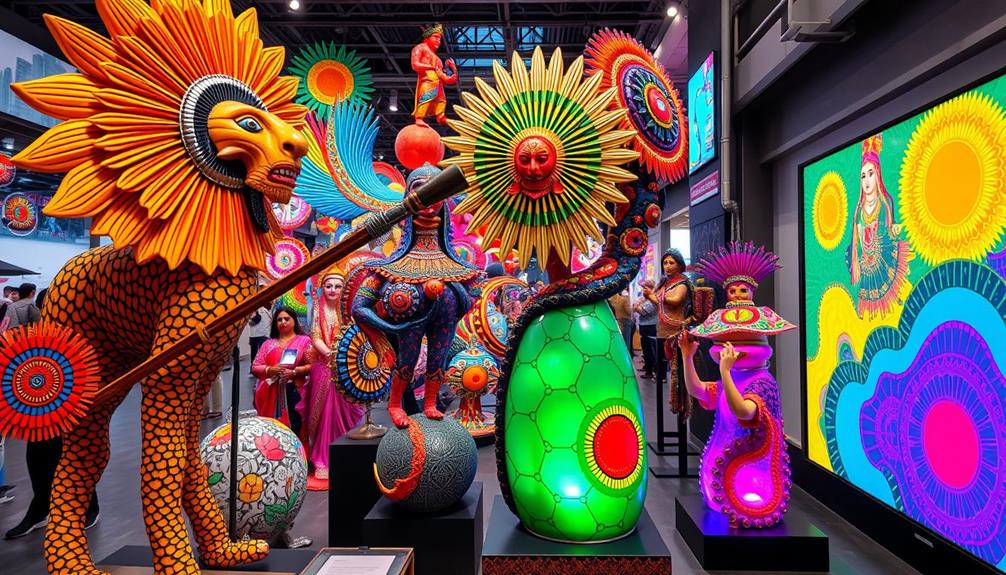
In today's art scene, you're witnessing a remarkable shift as artists blend digital advancements with traditional techniques.
The integration of technology is reminiscent of how AI and music creation is transforming creative processes, allowing for innovative collaborations that push boundaries.
Interactive installations are becoming a focal point, inviting you to engage with art in ways you've never experienced before.
As fusion techniques emerge, the boundaries of creativity are expanding, revealing new dimensions in artistic expression.
Digital Art Advancements
As technology evolves, digital art in India is experiencing a remarkable transformation, with artists harnessing innovative tools to push creative boundaries. Contemporary artists are leveraging techniques like algorithmic art and digital collages to explore themes that resonate with modern society; AI in Cybersecurity can also enhance creative processes by providing data-driven insights. This shift not only reflects personal narratives but also broader cultural dialogues.
The rise of online art galleries and social media platforms has notably enhanced the visibility of Indian digital artists, allowing them to showcase their work to a global audience. As a result, collaborations are flourishing, paving the way for exciting new projects that blend diverse artistic visions.
Moreover, augmented reality (AR) is redefining the viewer experience, creating interactive installations that invite engagement. Venues like The Designera pop art gallery exemplify how AR can transform traditional art appreciation into immersive journeys.
The pandemic played an essential role, accelerating the adoption of digital platforms for art creation and sales. Virtual exhibitions became the norm, enabling artists and galleries to connect with audiences despite lockdowns.
Educational institutions are also embracing this trend, incorporating digital art techniques into their curricula, nurturing a new generation of artists who blend tradition with technology.
Interactive Installations Unveiled
The rise of digital art has paved the way for an exciting trend in the Indian art scene: interactive installations. These installations engage you through immersive experiences that blend technology with traditional art forms.
At exhibitions like the India Art Fair 2023, you'll encounter remarkable interactive pieces, such as Debashish Paul's performance art that investigates queer identity, showcasing social themes while inviting your participation. This innovative approach mirrors the therapeutic benefits found in practices like essential oils for relaxation, enhancing emotional well-being while inviting creative expression.
Artists like Sudarshan Shetty and Shrimanti Saha are leading the charge with their public projects, encouraging audience involvement and prompting reflection on contemporary issues. The integration of augmented reality in these installations transforms your interaction with art, making it more innovative and enriching.
This technology not only enhances your understanding of the artwork but also deepens your connection to the themes presented. Interactive installations are redefining how you experience art, expanding the dialogue surrounding inclusivity and community engagement.
In contemporary Indian culture, these works invite you to become active participants rather than passive observers, fostering a richer relationship with the art and its messages. As you explore these dynamic installations, you'll find that they resonate on multiple levels, making art more accessible and relevant to your everyday life.
Fusion Techniques Explored
Fusion techniques are transforming the landscape of contemporary Indian art, where artists blend traditional styles like Madhubani and Warli with modern methods. This innovative fusion of traditional and contemporary practices resonates with both local and global audiences and often reflects deeper psychological themes, akin to the dynamics observed in narcissistic relationships.
Take Bharti Kher, for example; her work incorporates bindis into modern installations, showcasing how traditional elements can be reinterpreted in fresh contexts.
Emerging artists are also pushing boundaries by using mixed media, combining painting, sculpture, and digital art. This approach enhances visual storytelling and challenges conventional norms.
Jitish Kallat's "Covering Letter" exemplifies this trend by juxtaposing historical narratives with modern materials, bridging the gap between past and present.
Contemporary galleries are increasingly showcasing these dynamic works, fostering a vibrant dialogue within the Indian art scene. This encourages exploration and experimentation, allowing emerging artists to carve their unique paths.
As you engage with this evolving landscape, you'll find that the fusion techniques not only revitalize traditional art forms but also invite you to experience a richer, more engaging narrative that celebrates India's diverse cultural heritage.
Blending Old and New Techniques
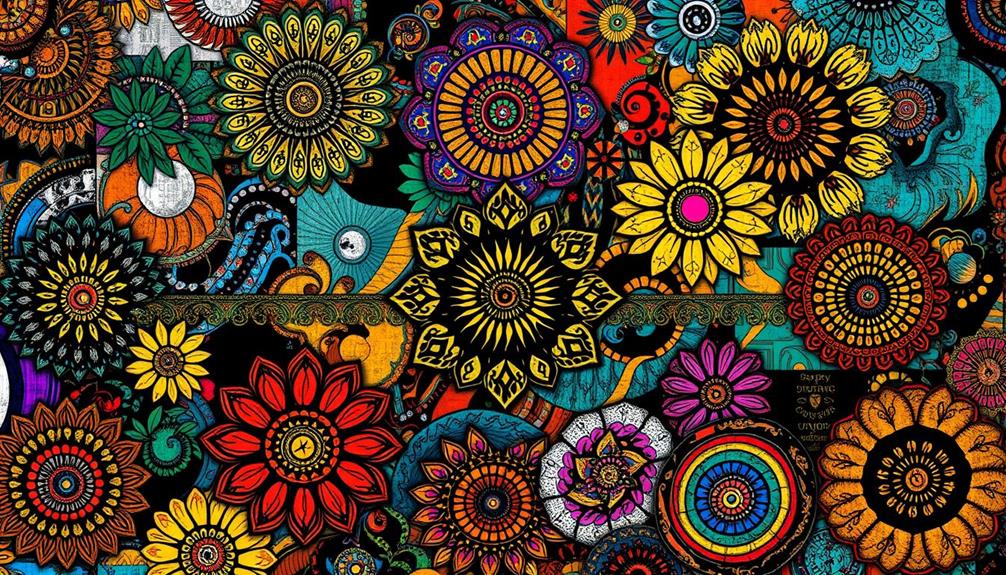
A vibrant dialogue between tradition and modernity defines contemporary Indian art, where artists skillfully blend age-old techniques with innovative approaches. You'll see how contemporary Indian artists are merging traditional forms like miniature painting and Madhubani with modern styles, creating works that resonate with both historical significance and contemporary themes.
The fusion of ancient art with modern technology illustrates this dynamic conversation. For instance, Bharti Kher's installations using bindis exemplify this blend, while Jitish Kallat juxtaposes traditional letters with contemporary materials, crafting compelling narratives. This blending of old and new techniques revitalizes interest in traditional art forms, making them relevant in today's context.
| Traditional Techniques | Modern Techniques | Notable Artists |
|---|---|---|
| Miniature Painting | Digital Installations | Bharti Kher |
| Madhubani Art | Mixed Media Collages | Jitish Kallat |
| Warli Art | Abstract Expressionism | Various Contemporary Artists |
| Tanjore Painting | Conceptual Art | Emerging Talents |
This growing popularity of hybrid forms showcases how blending traditional and modern not only enhances cultural exchange but also contributes uniquely to the global art scene.
Cultural Relevance of Traditional Art
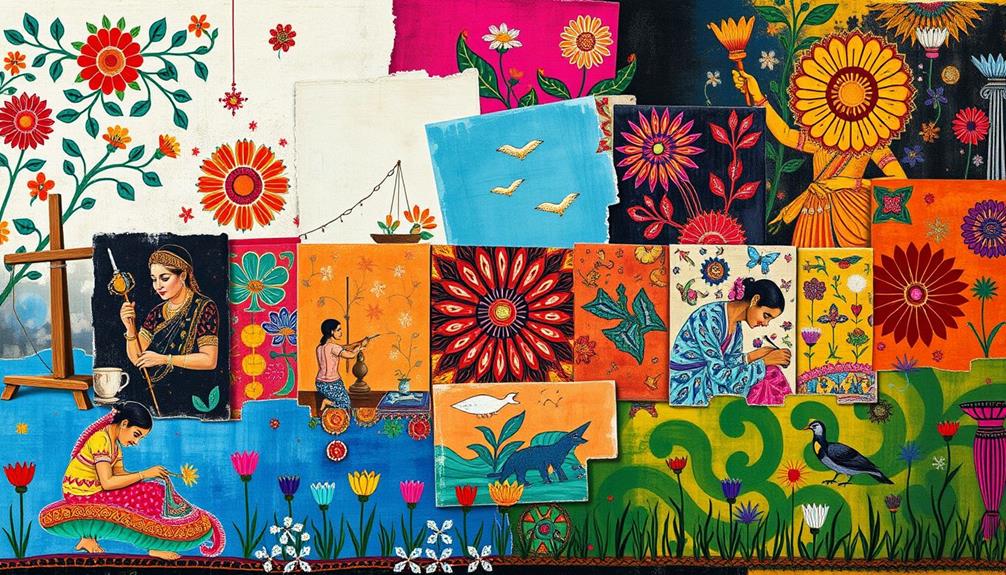
Traditional Indian art forms like Madhubani and Warli carry deep cultural significance, reflecting the country's rich heritage and spiritual beliefs. These traditional art styles utilize natural materials and intricate patterns, showcasing craftsmanship that's been passed down through generations.
They're not just visually stunning; they embody the narratives and values of various communities. As these art forms evolve, they also promote celebrating family bonds and shared experiences, enhancing their cultural relevance.
You'll notice contemporary artists increasingly integrating traditional techniques into their modern works. This fusion revitalizes interest and guarantees that these age-old practices remain relevant in today's art landscape. By doing so, they preserve the essence of Indian cultural heritage while adapting it to contemporary themes.
The preservation and evolution of traditional art are essential for maintaining India's cultural identity. As you explore these art forms, you'll gain insights into historical narratives and social values that have shaped the nation.
Additionally, Indian art galleries play an important role in promoting traditional art, offering platforms for emerging artists to showcase their unique interpretations and engage with global audiences.
In this way, traditional art continues to resonate, bridging the past with the present and guaranteeing that the richness of India's cultural heritage is celebrated and preserved for future generations.
Impact of Art Galleries
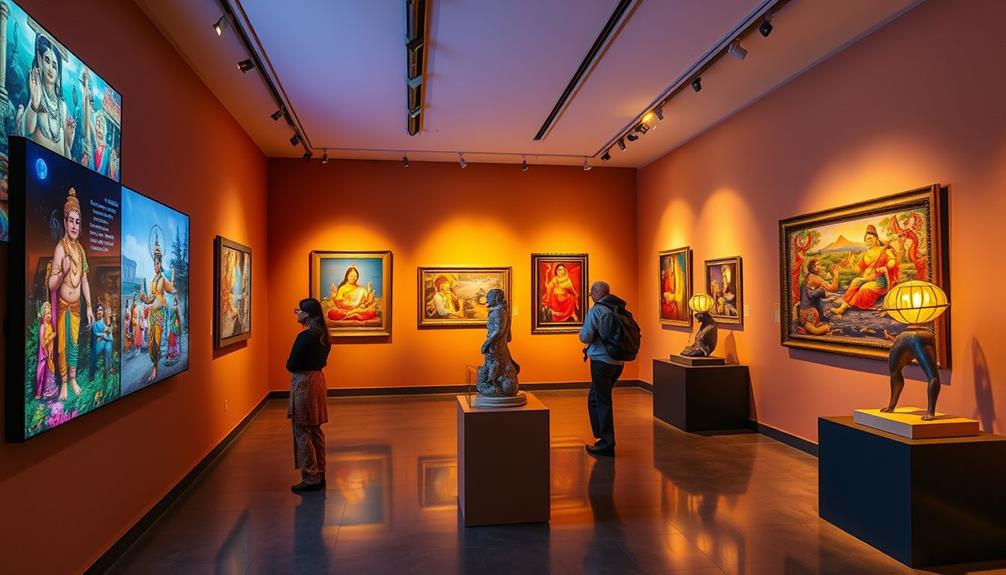
Art galleries greatly shape the contemporary art landscape in India, acting as essential platforms for artists to showcase their work. They play a pivotal role in promoting contemporary artists by providing spaces that celebrate diverse styles and genres.
Additionally, these galleries often reflect broader economic trends, much like how gold prices have shown resilience during economic downturns, highlighting the importance of stability in both art and finance.
Here's how art galleries impact the Indian art scene:
- They connect artists, critics, and collectors, fostering valuable relationships.
- Exhibitions blend traditional and modern art forms, allowing innovation within cultural heritage.
- Prominent galleries like Vadehra Art Gallery and Gallery Espace spotlight both established and emerging talents.
- They host international artists, promoting cultural exchange and enhancing global dialogue.
- By facilitating sales, art galleries contribute to the economic sustainability of artists.
These galleries are more than just exhibition spaces; they're vibrant hubs that nurture the growth of Indian art.
By showcasing contemporary artists, they help elevate the visibility of local talent on a global stage. Your engagement with art galleries not only enriches your appreciation for Indian art but also supports the artists and their journey.
Essentially, art galleries are fundamental to the evolving narrative of contemporary art in India, bridging the gap between tradition and modernity.
Digital Transformation in Art
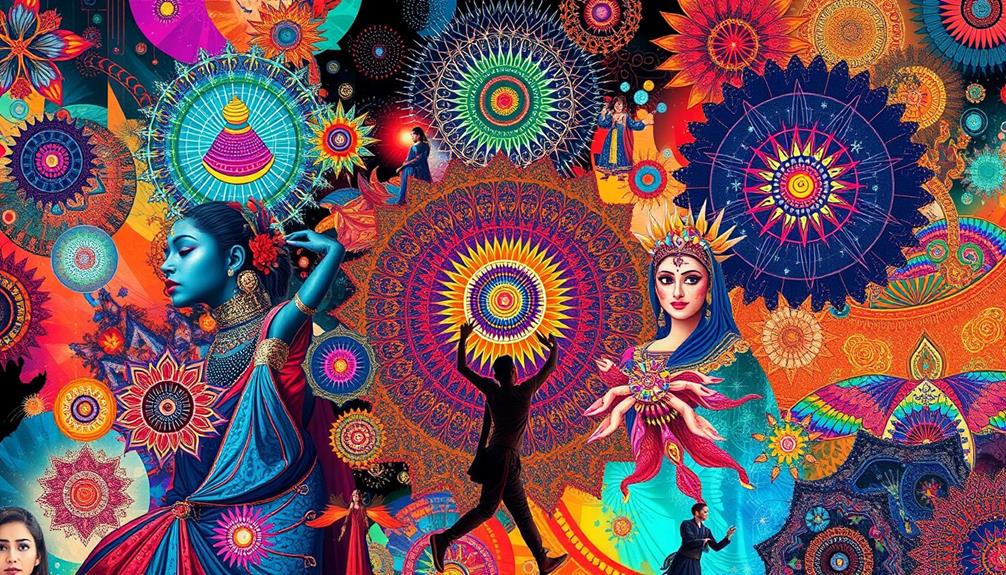
With the rise of digital platforms, artists in India are transforming how they create and showcase their work. Digitisation has opened up new avenues for creativity, allowing you to explore innovative forms like digital art, algorithmic art, and digital collages. This shift not only challenges traditional artistic boundaries but also enhances accessibility and global reach for Indian artists.
As niche marketing strategies continue to yield higher ROI, artists can effectively position themselves within specialized markets.
Social media plays an essential role in your journey as an artist, enabling you to connect with wider audiences and promote your work beyond physical art galleries. The pandemic accelerated this change, proving that online exhibitions and virtual galleries are vital for maintaining cultural discourse and engaging with art lovers.
Emerging art spaces, such as India's first pop art gallery, are incorporating augmented reality and AI technologies, offering you exciting new ways to express your creativity.
These platforms support grassroots talent and reflect the evolving landscape of Indian art. As you embrace these digital transformations, you're not just adapting to change; you're actively shaping the future of art in India, making your mark on a global stage.
Global Influences on Indian Art
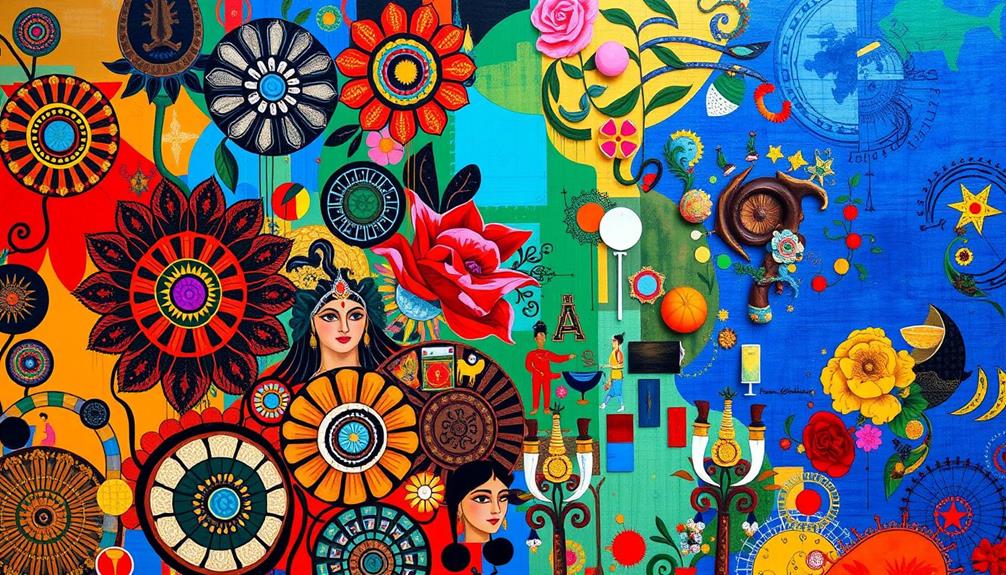
As you explore the global influences on Indian art, you'll notice how cultural exchanges are reshaping traditional practices.
The incorporation of design thinking principles is fostering a more user-centered approach in artistic creation, enabling artists to connect with international trends.
Technology and innovation play an essential role in this transformation, allowing artists to connect with international trends.
International collaborations further enhance this dynamic, creating a vibrant dialogue that enriches the Indian art scene.
Cultural Exchange Dynamics
Cultural exchange enriches the tapestry of Indian art, reflecting a vibrant interplay between local traditions and global influences. You'll find that contemporary Indian artists are harnessing this dynamic, integrating various global art movements into their works. This fusion not only enhances their creativity but also elevates their visibility on international platforms.
For instance, the evolution of celebrity relationships, such as Jennifer Aniston and Brad Pitt's friendship, illustrates how personal dynamics can influence broader cultural narratives.
- The India Art Fair 2023 showcased international galleries, fostering collaboration.
- Digital art initiatives, like augmented reality projects, are reshaping the landscape.
- Social media connects Indian artists with global audiences, broadening their reach.
- Collaborative projects, such as BMW India's art car wrap, blend cultural narratives.
- Global art trends inspire unique techniques in the Indian art scene.
These elements illustrate how cultural exchange is essential for contemporary Indian art. Through collaborative projects and innovative platforms, artists engage in cross-cultural dialogue, expanding their artistic horizons.
Technology and Innovation
Technology and innovation are revolutionizing the Indian art scene, enabling artists to push boundaries and explore new mediums. The integration of digital art forms, like algorithmic art and digital collages, has transformed how you experience and interact with art. These innovative techniques allow artists to reach wider audiences through online platforms, making art more accessible than ever.
Augmented reality (AR) is enhancing viewer engagement, letting you visualize artistic concepts instantly and blurring the lines between physical and digital experiences. At The Designera, India's first pop art gallery, artists embrace augmented reality and artificial intelligence to support emerging talent and foster creative experimentation.
Moreover, digital platforms and social media have accelerated the visibility of Indian artists, facilitating global engagement and collaboration. You can now explore virtual exhibitions and online galleries that showcase diverse artworks from the comfort of your home.
The pandemic has acted as a catalyst for this digitization, pushing galleries and artists to adapt to digital mediums, thereby reshaping traditional art sales and consumption. As a result, the Indian art landscape is evolving, offering you fresh perspectives and experiences through technology and innovation.
International Collaborations Impact
Collaboration is reshaping the landscape of Indian art, infusing it with global perspectives and fresh ideas. As you explore contemporary Indian art, you'll notice how these international ties enhance creativity and broaden narratives.
Here are some key influences:
- Renowned international artists like Anish Kapoor and Rina Banerjee showcased by global galleries.
- Innovative projects like BMW India's "The Future is Born of Art" highlighting modernity and sustainability.
- Cross-cultural dialogue fostered through international participation in art fairs, such as the India Art Fair.
- Digital art initiatives showcasing works from Digital Artists in Residence that integrate global tech advancements.
- Performance pieces, like Debashish Paul's exploration of queer identity, reflecting international socio-political themes.
These collaborations not only elevate the visibility of Indian artists but also enrich the art scene with diverse influences.
You'll find that contemporary Indian art is now a vibrant tapestry woven with threads of global ideas, styles, and issues. As you engage with these works, you'll witness how international partnerships continue to shape the future of art in India.
Emerging Artists and Trends
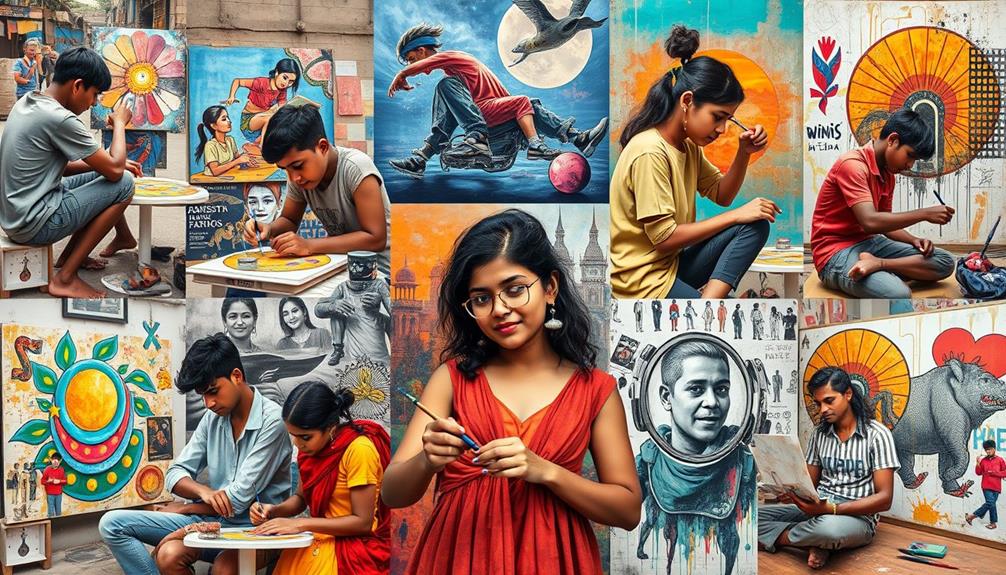
In the vibrant landscape of contemporary Indian art, a new generation of artists is emerging with a fresh perspective that fuses traditional techniques with modern themes.
These emerging artists are gaining recognition for their innovative practices, creating unique visual narratives that resonate with today's audience. One significant trend is the rise of street art, where vibrant murals and installations are transforming urban spaces while addressing pressing social and political issues.
You'll find that many of these talented individuals are leveraging digital platforms and social media to showcase their work, expanding their reach and connecting with global audiences.
This shift not only democratizes art but also enables artists to engage directly with their followers and collectors.
Moreover, the integration of technology in art creation, such as augmented reality and AI, is becoming prevalent.
This allows you to see artists pushing creative boundaries and experimenting with new mediums.
Collaborative projects and community-focused initiatives are also fostering a supportive environment, encouraging artistic experimentation and cultural exchange.
Future Directions in Indian Art
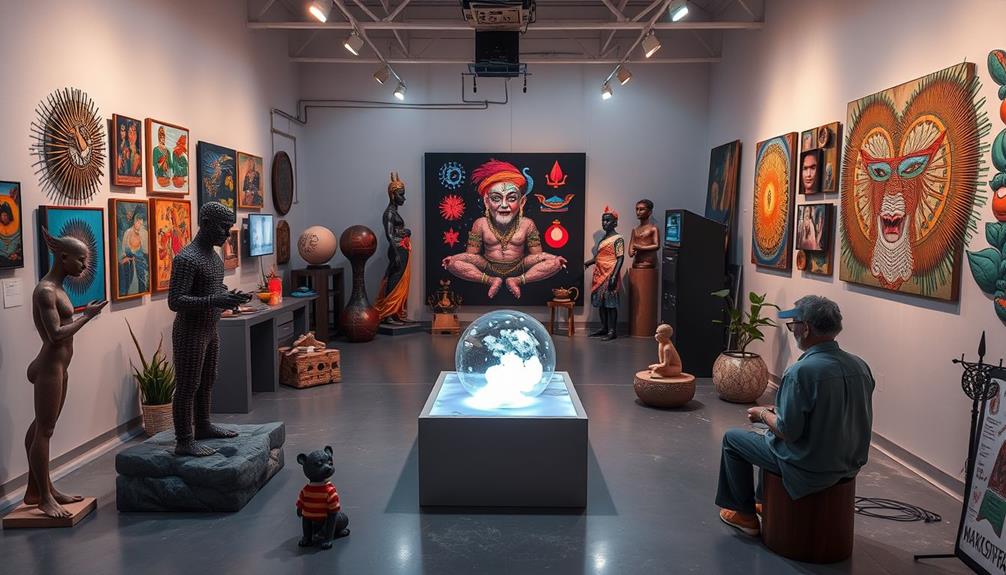
As the Indian art scene evolves, artists are embracing innovative tools and mediums that reshape their creative expressions. The future of Indian art is bright, driven by technology and a shift towards modern practices.
Here's what you can expect:
- Integration of augmented reality to enhance viewer engagement
- Artificial intelligence as a tool for instant concept visualization
- Digital platforms fostering faster art creation and distribution
- Social media providing a global canvas for emerging artists
- Interdisciplinary practices blending traditional techniques with modern concepts
Emerging artists are at the forefront of this transformation, using social media to amplify their voices and tackle contemporary themes.
The pandemic accelerated the adoption of online galleries and virtual exhibitions, making art more accessible than ever.
You'll witness a growing emphasis on interdisciplinary practices, where artists fuse age-old techniques with modern materials, creating dynamic forms that challenge the conventional boundaries of art.
Initiatives like India's first pop art gallery, The Designera, highlight this trend, supporting grassroots talent while integrating technology into art.
The future of Indian art promises to be innovative, diverse, and immensely engaging.
Frequently Asked Questions
What Is Edge of Desire Recent Art in India?
"Edge of Desire" showcases contemporary art in India, exploring themes of desire and identity. You'll see diverse artists using innovative techniques, challenging norms, and sparking discussions about modern social dynamics and individual experiences within society.
What Is the Art Style of India?
Did you know that over 200 distinct art styles exist in India? You'll discover vibrant traditions like Madhubani and Warli, each showcasing unique techniques, narratives, and cultural heritage that enrich the Indian art landscape.
What Are the Main Characteristics of Indian Painting?
Indian painting's main characteristics include intricate details, vibrant colors, and the use of natural materials. You'll find spiritual themes in traditional styles like Madhubani and Kalamkari, reflecting India's diverse cultural narratives and rich heritage.
How Did Indian Art Change After the Indian Independence in 1947?
After Indian Independence in 1947, you'll notice artists blending traditional styles with modern influences, addressing social issues. This shift sparked new movements, encouraging experimentation with techniques and materials, reshaping the landscape of Indian art considerably.
Conclusion
As you explore the vibrant Indian art scene, you'll see how traditional techniques blend seamlessly with modern innovations, creating a dynamic landscape that's nothing short of a creative explosion. The impact of digital transformation and global influences can't be overstated, as emerging artists push boundaries like never before. With each brushstroke and pixel, the future of Indian art promises to be as enchanting as a thousand sunsets, inviting you to witness its evolution firsthand.
